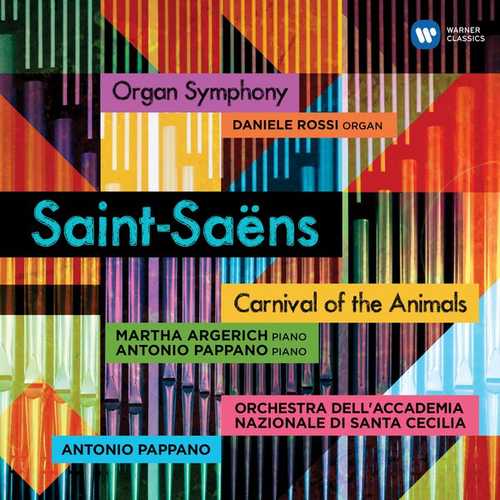

Composer: Charles Camille Saint-Saëns
Performer: Daniele Rossi, Martha Argerich, Antonio Pappano
Orchestra: Orchestra dell’Accademia Nazionale di Santa Cecilia
Conductor: Antonio Pappano
Format: FLAC (tracks)
Label: Warner
Catalogue: 9029575555
Release: 2017
Size: 782 MB
Recovery: +3%
Scan: yes
Symphony No. 3 in C minor, Op. 78 ‘Organ Symphony’
01. Ia. Adagio – Allegro moderato
02. Ib. Poco adagio
03. IIa. Allegro moderato – Presto
04. IIb. Maestoso – Allegro
Le carnaval des animaux
05. Introduction and Royal March of the Lion
06. No. 2 Hens and Roosters
07. No. 3 Wild Asses
08 .No. 4 Tortoises
09 .No. 5 The Elephant
10. No. 6 Kangaroos
11. No. 7 Aquarium
12. No. 8 People with Long Ears
13. No. 9 Cuckoo in the Heart of the Woods
14. No. 10 Aviary
15. No. 11 Pianists
16. No. 12 Fossils
17. No. 13 The Swan
18. No. 14 Finale
The pianists are perhaps the most exotic of all the creatures in the Carnival of the Animals. A very rare and treasurable pairing has been made by Warner Classics for this new recording of Saint-Saëns’ enchantingly witty suite: Martha Argerich, often described as the world’s finest example of the pianist species, and Antonio Pappano, a particularly fine specimen of the conductor-pianist.
Beside such natural wonders as the graceful swan, the mighty lion, the waltzing elephant, the iridescent denizens of the aquarium and the rattling fossils, the pianists are the prize exhibits of the Carnival, bringing their colour and virtuosity to all but one of its fourteen movements. Their big solo moment comes towards the end of proceedings as they relentlessly practise their scales, which are punctuated with peremptory chords from the strings.
Argerich and Pappano met in Italy for the recording – not in Venice, the city of Carnival, but in Rome, where, since 2005, Pappano has been Music Director of the Orchestra dell’Accademia Nazionale di Santa Cecilia. Nine of its players partner the two star pianists in Saint-Saëns’ suite. In 2012, when Argerich performed Schumann’s Piano Concerto with the Orchestra dell’Accademia Nazionale di Santa Cecilia, Pappano told Euronews that he was “just knocked over by the amount of energy that she has, but actually what she does is always extremely natural, as if the music can’t go any other way.” Argerich’s daughter, Annie Dutoit also makes a contribution to the Carnival: she recites verses written for the piece by the French actor, singer, humorist Francis Blanche (1921-1974).
The Carnival shares the album release with another of Saint-Saëns’ most celebrated works, the magnificent Symphony No. 3. The prominent organ part is played by Daniele Rossi. Both the Carnival and the Symphony No. 3 were composed in the same year, 1886, but their aesthetics could hardly be more different. In Spring 2016 the Symphony No. 3 featured on a European tour that Pappano made with the Orchestra dell’Accademia Nazionale di Santa Cecilia. In Germany, the Hamburger Abendblatt reported that the audience responded to the performance of the symphony with “euphoria …stamping on the ground and calling for two encores,” while the Frankfurter Rundschau wrote that “under Pappano’s inspiring direction the Italian musicians captured the reverential, ethereal atmosphere [of the first movement’s Poco adagio] with the same precision as the circus-like uproar of its combined instrumental masses [in the Allegro finale].” This was the last symphony that Saint-Saëns composed, though he lived for a further 35 years. When asked why, he responded: “With it I have given all I could give. What I did I could not achieve again.”